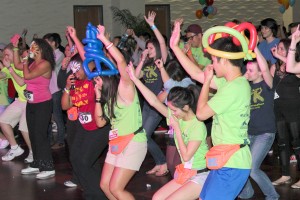Dance Marathon grows from humble beginnings
On first glance, this could be any party on campus: Fists pumping in the air, music bursting through the speakers and spotlights giving the venue an acid-trip glow.

For the kids · USC students danced the night away in support of local hospitals affiliated with the Children’s Miracle Network Dance. The annual 12-hour event had “theme hours” throughout the night, such as the ’90s hour. – Karen Pham | Daily Trojan
But upon closer inspection, it is clear from the balloon animals adorning students heads to the young children dancing that this isn’t your typical USC rager — this is Trojan Dance Marathon.
For the past couple of months, the people behind the event have been working hard to make the night a success. From making their mark on campus in the form of neon flyers to sidewalk chalk announcements, they advertised and promoted the dance until the last moment leading up to the annual event.
The core members of the annual Dance Marathon at USC — more widely known as Trojan Dance Marathon — can now breathe a sigh of relief after yet another successful 12-hour charity event.
Dance Marathon is a nationwide event held at more than 150 colleges, including USC, that aims to raise money for local hospitals affiliated with the Children’s Miracle Network.
The Trojan Dance marathon is in its sixth year at USC and has grown tremendously since its earlier, humbler beginnings. Originally, the Trojan Dance marathon started in the 1990s, but because of a lack of interest, the momentum behind the event faded away. But the idea resurfaced again in 2007 when then-sophomore Suzanne Fitzgerald and freshman Scott Slesinger, two USC students who had both heard about these annual dance marathons, crossed paths.
After finding an advisor and meeting with board members of the Children’s Miracle Network, USC held its first dance marathon at Ground Zero and raised $6,500 during a six-hour, 200-person event. In 2009, the event was moved to the Lyon Center because of increased attendance and interest. But the next year saw even more participants and so the marathon was moved to one of the biggest venues on campus — the Tutor Campus Center Ballroom.
But this steady increase in awareness of the dance marathon was not by accident. Starting with Fitzgerald and Slesinger, word of this event spread with effective marketing and PR campaigns. The Trojan Dance Marathon founders implemented catchy slogans like “Feel the beat” on team shirts and branded the event to the point that most everyone on campus knew what “TDM” stood for, if asked.
And it’s this degree of passion and hard work that makes this event so popular.
Shelby DeWeese, who serves as the residential relations coordinator, joined the executive team after becoming smitten with the event and its overall message.
“A lot of times, fundraising programs can feel really mechanical and the Dance Marathon does a good job of fundraising and reminding the people who are involved about the other humans that they are impacting,” DeWeese said.
Like most dance parties, it takes some time to get warmed up, but at the Trojan Dance Marathon, it did not take long before the festivities were underway. From time to time, the marathon team came together to show off their practiced and polished dancing routines. “Theme hours,” such as the ’90s hour and around-the-world hour, were particularly intriguing segments that tailored the music and activities to a certain theme, keeping up a frequent change in pace that kept the dancers happy and active.
But on the back of the marathon shirts, the acronym “FTK” (or “For the Kids”) symbolized a theme that remained consistent throughout the night. Between theme hours and dancing, “Miracle Children,” current and former patients at the Children’s Hospital of Los Angeles, went up on stage and told their stories to the dancers.
For Jenny Chen, the external director of Trojan Dance Marathon, the driving force of fundraising for this event is, in part, what the kids have gone through.
“[The children] have such confidence and courage to share their story and they make us so in awe,” Chen said. “One of them, Eileen, is an amazing singer and even started her own charity with a friend. CHLA helped Eileen get past the illnesses she was battling so she can achieve her dreams. And that’s what we love to see.”
The final theme hour was rung in with glow sticks and upbeat music, signifying the home stretch.
In the end, a total of more than $50,000 was raised, an amount that came up a bit short compared to last year but still stands as an enormous sum.
In her last year at both USC and Trojan Dance Marathon, Director of Administration Sara McElroy said that she hopes to see the organization continue to grow.
“Dance Marathon is all over the country. One of the biggest ones is Thon at Penn State, and it’s so big and it’s the event of the year,” McElroy said. “If that could be here, I would love it. If it can’t but makes a difference in people’s lives [though], that’s all that really matters.”
Donations are still accepted one month after the Trojan Dance Marathon. If you are interested in donating to the cause, you can visit www.trojandm.org.

Sounds like a great event for a great cause.
All the planners and students should be proud of themselves!